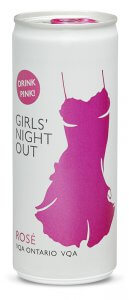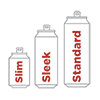
Over the past few years, more of the world’s small-batch wine makers have come to the same conclusion of their beer- making peers: Cans are the ultimate package for fermented beverages. Cask machines feature the perfect combinations of features for wineries looking to taking advantage of the many benefits of cans.


Standard, Slim or Sleek!
Cask canning lines accommodate numerous coffee-appropriate can sizes, in any Standard, Slim or Sleek formats ranging from 163mL/5.5oz to 568mL/19.2oz with minimal changeover time.

Inline Scale & Auto Reject
An inline scale provides onscreen trending of can weights to 2g accuracy, in real time. Get instant operator feedback for fill consistency and adjustments, with an auto reject arm that automatically purges out-of-spec cans onto a catch tray.
![]()
Industry Leading Fill Tech
Cask’s level-sensing probes ensure more consistent fills than other technology (timed filling systems, for example),to eliminate variables in brite tank head pressure or temperature that can lead to over- or under-filled cans.
Cask System Features for Canned Wine
- Cask canning lines are nitrogen-doser ready for the canning of still wines.
- The purpose of nitro-dosing when canning still wines is primarily to provide internal pressure in the can to maintain the filled can’s rigidity, strength and integrity during distribution. Filled cans of wine without nitrogen don’t hold their shape and easily crush.
- Nitrogen also aids in minimizing oxygen pickup in the can during filling and seaming.
- Nitrogen gas is typically used to purge oxygen from cans prior to filling and for under-lid gassing. But Cask canning systems are also compatible with an argon gas purge which is sometimes preferred when canning wine.
- Both still and sparkling wines are able to be canned on the same system.
- Your canning line can accommodate any wine-appropriate can sizes (typically 6.3oz/187mL, 8.4oz/250mL, 12.7oz/375mL and 16.9oz/500mL per the TTB’s Certificate of Label Approval/Exemption (COLA)).
- Your canning line could accommodate any Slim, Sleek or Standard diameter can size on the market ranging from as small as 163mL/5.5oz to as large as 568mL/19.2oz. Change over time between multiple can heights can be as quick as 30 minutes, and is closer to an hour when changing between multiple diameters.
- The ability to package multiple diameters allows versatility in co-packing with other craft beverages.
- We use food grade stainless steel for our systems (less plastic or anodized aluminum), so wineries can use heavier sanitization agents when cleaning to prevent any cross-contamination. Other systems with more plastic components must use more diluted sanitization agents, to avoid the risk of degrading plastic components and frequent replacement of these plastic components.
- Cask systems have level-sensing probes to ensure proper fills more consistently than other technologies such as timed filling systems. Timed systems can create variability in brite-tank head pressure or temperature during a canning run, which can result in over- or under-filled cans.
- Our ACS V5 and fleX2 have inline scales that provide onscreen trending of can weights to 2g accuracy, in real time. Get instant operator feedback for fill consistency and adjustments, with an auto reject arm that automatically purges out-of-spec cans onto a catch tray, allowing unparalleled quality control of your finished packaged product.
Interested in more information or a quotation?
Getting your Wine into Cans
- Cask and Ball Corporation, the world’s largest aluminum can producer, will work closely with you to ensure that your wine is ready for the mighty aluminum can. Ball chemists will test the corrosivity of your wine and also look at total alcohol content, pH, free SO2, copper and dissolved oxygen (DO), and other factors. These steps ensure your wine will be shelf stable and maintain peak quality after packaging.
- A State of California Proposition 65 compliant BPA Non-Intent (BPANI) liner is available from Ball Corporation.
- BPA can come from many sources, including water used in beverages, metal pipes used to transport water and other ingredients used to make beverages.
- Using BPANI linings means that no BPA was intentionally added to the lining by Ball or Ball’s suppliers.
